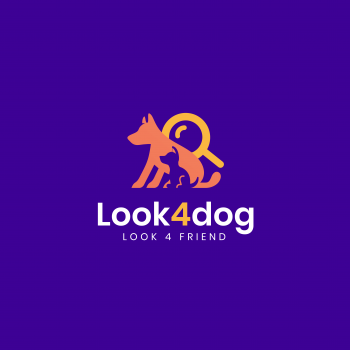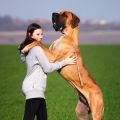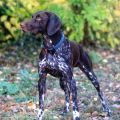The Deutsch Langhaar, also known as the German long-haired Pointing Dog, is a versatile and intelligent breed that excels in various activities such as hunting, tracking, and search and rescue. With its striking appearance and exceptional skills, this breed has gained popularity not only in Germany but also worldwide.
Originating in Germany, the Deutsch Langhaar has a rich history that dates back to the 19th century. It was developed by crossing various German hunting breeds, including the German Pointer, German Spaniel, and German Setter. The goal was to create a versatile hunting dog that could track, point, and retrieve game both on land and in water.
According to the FCI (Fédération Cynologique Internationale) typology, the Deutsch Langhaar belongs to Group 7: Pointing Dogs. Within this group, it is classified under Section 1.2: Continental Pointing Dogs, and its standard number is 117. This classification highlights the breed's exceptional pointing abilities and its suitability for hunting purposes.
The Deutsch Langhaar is primarily bred for hunting, making it an excellent choice for hunters and outdoor enthusiasts. Its exceptional scenting abilities, strong pointing instinct, and natural retrieving skills make it a valuable asset in the field. Additionally, its calm and obedient nature, combined with its high trainability, make it an ideal companion for active individuals or families who enjoy outdoor activities.
In terms of physical characteristics, the Deutsch Langhaar is a medium to large-sized dog with a well-muscled and athletic build. Males typically stand between 24 to 26 inches (60 to 66 cm) at the shoulder, while females are slightly smaller, ranging from 22 to 24 inches (56 to 61 cm). The breed's weight ranges from 55 to 77 pounds (25 to 35 kg), with males being slightly heavier than females.
One notable feature of the Deutsch Langhaar is its long, dense, and water-repellent coat, which provides excellent protection in various weather conditions. The coat is typically wavy or slightly curly, and it requires regular grooming to prevent matting and maintain its quality. The breed's coat color can vary, with combinations of brown, white, and black being the most common.
The Deutsch Langhaar has a life expectancy of around 12 to 14 years, which is relatively long for a medium to large-sized breed. However, it is important to note that proper care, nutrition, and regular exercise are essential to ensure the dog's overall health and longevity.
Aside from its hunting abilities, the Deutsch Langhaar possesses several other interesting traits. It is known for its friendly and gentle nature, making it an excellent family dog. It is generally good with children and other pets, although early socialization and proper training are crucial to ensure proper behavior.
Furthermore, the Deutsch Langhaar is highly intelligent and eager to please, making it relatively easy to train. It excels in various dog sports such as obedience, agility, and tracking. Mental stimulation and regular exercise are essential to keep this breed happy and content.
In conclusion, the Deutsch Langhaar is a remarkable breed that combines beauty, intelligence, and versatility. With its exceptional hunting skills, friendly temperament, and adaptability, it is an ideal choice for hunters, outdoor enthusiasts, and active families. Whether in the field or as a loyal companion, the Deutsch Langhaar is a breed that brings joy and fulfillment to its owners.
The Deutsch Langhaar, also known as the German long-haired Pointing Dog, is a versatile and intelligent breed that possesses a unique character. These dogs are highly regarded for their exceptional hunting skills, loyalty, and gentle nature. With proper training and socialization, they make excellent family pets and reliable working companions.
In terms of character, Deutsch Langhaars are known for their calm and composed demeanor. They are generally friendly and affectionate towards their family members, including children and other pets. However, they can be reserved and cautious around strangers, making them excellent watchdogs. Their protective instincts, combined with their intelligence, make them quick to assess potential threats and act accordingly.
These dogs have a strong desire to please their owners, which makes them highly trainable. They are known for their exceptional obedience and willingness to learn. However, it is important to note that Deutsch Langhaars require a firm and consistent hand in training. Positive reinforcement techniques, such as treats and praise, work best with this breed. Harsh training methods or punishment can lead to fear or aggression, so it is crucial to use gentle and patient methods.
As hunting dogs, Deutsch Langhaars have a natural instinct for tracking and pointing game. They possess a keen sense of smell and excellent stamina, making them ideal for long hunting trips. Their long, dense coat protects them from harsh weather conditions, allowing them to work in various terrains. These dogs are versatile and can adapt to different types of game, including birds, rabbits, and even larger game like deer.
To raise a Deutsch Langhaar puppy, early socialization is key. Expose them to various environments, people, and animals from a young age to ensure they grow up to be well-rounded and confident dogs. Regular exercise is also essential to keep them physically and mentally stimulated. Engaging in activities such as long walks, runs, or even participating in dog sports like agility or obedience trials can help channel their energy and prevent boredom.
Training should start as early as possible, focusing on basic obedience commands such as sit, stay, and recall. As they mature, more advanced training can be introduced, including hunting-specific commands like tracking and retrieving. Consistency, patience, and positive reinforcement are crucial throughout the training process.
Deutsch Langhaars thrive in an environment where they receive plenty of mental and physical stimulation. They are not well-suited for apartment living and require a spacious yard to roam and explore. Regular grooming is necessary to maintain their long, dense coat, which can become tangled or matted if not properly cared for.
In conclusion, Deutsch Langhaar dogs are known for their calm and composed character, loyalty, and exceptional hunting abilities. With the right training, socialization, and care, they make wonderful family pets and reliable working companions. Their intelligence, willingness to please, and adaptability make them a highly sought-after breed for those looking for a versatile and devoted canine companion.
The Deutsch Langhaar, also known as the German long-haired Pointing Dog, is a versatile and intelligent breed that requires specific care to ensure their well-being and happiness. Here are some tips on how to care for dogs of this breed, including what to do and what not to do:
1. Grooming: The Deutsch Langhaar has a long, dense coat that requires regular grooming to prevent matting and keep it in good condition. Brush their coat at least once a week to remove loose hair and prevent tangles. Pay special attention to their feathering on the ears, legs, and tail. Regularly check their ears for any signs of infection and clean them gently with a veterinarian-approved solution.
2. Exercise: These dogs have a high energy level and require regular exercise to stay healthy and mentally stimulated. Aim for at least one hour of exercise daily, which can include walks, runs, or playtime in a secure, fenced area. Engage them in activities that challenge their intelligence, such as puzzle toys or obedience training.
3. Training: Deutsch Langhaars are highly trainable and eager to please. Start their training early, using positive reinforcement techniques such as treats, praise, and play. Consistency and patience are key to their success. Enroll them in obedience classes or work with a professional trainer to ensure they develop good manners and become well-socialized.
4. Socialization: Proper socialization is crucial for Deutsch Langhaars to become well-rounded dogs. Expose them to various environments, people, and other animals from a young age. This will help them develop confidence and prevent behavioral issues. Arrange playdates with other friendly dogs and introduce them to different sights, sounds, and experiences gradually.
5. Nutrition: Provide a balanced and nutritious diet that meets the specific needs of the Deutsch Langhaar. Consult with a veterinarian to determine the appropriate amount and type of food for your dog based on their age, size, and activity level. Avoid overfeeding to prevent obesity, which can lead to various health problems.
6. Health care: Regular veterinary check-ups are essential to ensure the overall health of your Deutsch Langhaar. Keep up with vaccinations, parasite prevention, and dental care. Monitor their weight, coat condition, and behavior for any signs of illness or discomfort. Seek immediate veterinary attention if you notice any abnormalities.
7. Mental stimulation: Deutsch Langhaars are intelligent dogs that thrive on mental stimulation. Provide them with interactive toys, puzzle games, and training sessions to keep their minds engaged. Engaging in activities like scent work or retrieving games can help satisfy their natural instincts.
What not to do:
1. Neglect grooming: Neglecting regular grooming can lead to matting, skin issues, and discomfort for your Deutsch Langhaar. Avoid letting their coat become tangled or dirty.
2. Leave them alone for long periods: Deutsch Langhaars are social dogs and can become anxious or bored if left alone for extended periods. Avoid leaving them alone for too long and provide them with mental and physical stimulation.
3. Use harsh training methods: These dogs respond best to positive reinforcement training methods. Avoid using harsh or punitive techniques, as it can damage their trust and hinder their progress.
4. Overfeed or feed inappropriate food: Overfeeding can lead to obesity, which can have detrimental effects on their health. Additionally, feeding them inappropriate food or table scraps can cause digestive issues. Stick to a balanced diet recommended by your veterinarian.
5. Skip regular exercise: Deutsch Langhaars require regular exercise to burn off energy and stay physically fit. Avoid skipping exercise sessions, as it can lead to behavioral problems or obesity.
By following these tips, you can provide the best care for your Deutsch Langhaar, ensuring they lead a happy and healthy life. Remember, each dog is unique, so always pay attention to their individual needs and consult with a veterinarian for personalized advice.
The Deutsch Langhaar, also known as the German long-haired Pointing Dog, is a majestic and versatile breed that possesses a distinctive coat color. These dogs exhibit a range of colors that are both aesthetically pleasing and functional in various hunting environments.
The most common color seen in Deutsch Langhaar dogs is a rich and lustrous liver, which is often referred to as "Schimmel" in German. This deep, chocolatey hue is the result of a combination of genes that determine the pigmentation of the coat. The liver coloration is evenly distributed throughout the body, giving the dog a harmonious and balanced appearance.
The coat of the Deutsch Langhaar is dense, long, and slightly wavy, providing protection against harsh weather conditions and underbrush. The liver color is most prominent on the body, while the ears, tail, and face may have slightly lighter shades. This variation in color adds depth and character to the overall appearance of the dog.
The liver color of the Deutsch Langhaar is often accompanied by white markings, which serve as a distinguishing feature of the breed. These markings can be found on the chest, paws, and tip of the tail. The white patches create a striking contrast against the rich liver color, enhancing the dog's elegant and regal presence.
In addition to the liver color, Deutsch Langhaar dogs may also exhibit a roan pattern. Roan refers to a mixture of colored and white hairs, creating a speckled or mottled effect. This pattern can be seen throughout the liver-colored coat, adding a unique and eye-catching element to the dog's appearance.
The color of the Deutsch Langhaar's coat not only contributes to its visual appeal but also serves a functional purpose. The liver coloration allows the dog to blend seamlessly into various hunting terrains, such as dense forests or open fields. This camouflage helps the dog remain inconspicuous while on the hunt, allowing it to approach game with stealth and precision.
In conclusion, the common color of Deutsch Langhaar dogs is a rich and lustrous liver, often accompanied by white markings. This coloration, along with the dense and wavy coat, adds to the breed's majestic and regal appearance. The liver color serves both an aesthetic and functional purpose, allowing the dog to blend into its surroundings during hunting expeditions.
The Deutsch Langhaar, also known as the German long-haired Pointing Dog, is a versatile and intelligent breed known for its exceptional hunting skills and loyal nature. When it comes to their health, Deutsch Langhaars are generally robust and have a good overall constitution. However, like any other breed, they are prone to certain health issues that owners should be aware of to ensure their well-being.
One of the most common health concerns in Deutsch Langhaars is hip dysplasia. This condition occurs when the hip joint doesn't develop properly, leading to discomfort, lameness, and eventually arthritis. To minimize the risk of hip dysplasia, it is crucial to obtain puppies from reputable breeders who conduct hip screenings on their breeding dogs. Regular exercise on soft surfaces, maintaining a healthy weight, and providing joint supplements can also help in preventing or managing this condition.
Another prevalent health issue in Deutsch Langhaars is progressive retinal atrophy (PRA). PRA is a degenerative eye disease that leads to gradual vision loss and, in severe cases, blindness. Responsible breeders will conduct eye screenings on their breeding dogs to ensure they are free from this condition. Regular eye check-ups with a veterinary ophthalmologist are recommended to detect any signs of PRA early on and provide appropriate management.
Deutsch Langhaars are also prone to ear infections due to their long, floppy ears that can trap moisture and debris. Regular ear cleaning with a veterinarian-recommended solution and keeping the ears dry can help prevent infections. It is essential to check the ears regularly for any signs of redness, swelling, or discharge and seek veterinary attention if any abnormalities are noticed.
Maintaining proper dental hygiene is crucial for the overall health of Deutsch Langhaars. Regular brushing of their teeth, providing dental chews or toys, and scheduling professional dental cleanings can help prevent periodontal disease, which can lead to tooth loss and other health complications.
To ensure the overall well-being of Deutsch Langhaars, a balanced diet is essential. Feeding them high-quality dog food that meets their nutritional needs is crucial. Avoiding overfeeding and providing regular exercise to prevent obesity is also important, as excess weight can lead to various health issues, including joint problems and heart disease.
Regular veterinary check-ups are vital for early detection and prevention of any potential health concerns. Vaccinations, parasite prevention, and routine blood work are all part of maintaining the health of Deutsch Langhaars. Additionally, providing mental stimulation, socialization, and regular exercise are crucial for their overall well-being and to prevent behavioral issues that can arise from boredom or lack of mental and physical stimulation.
In conclusion, Deutsch Langhaars are generally healthy dogs, but like any breed, they have specific health concerns that owners should be aware of. Regular veterinary care, proper nutrition, exercise, and preventive measures such as screenings for hip dysplasia and PRA are essential for maintaining their health. With proper care and attention, Deutsch Langhaars can lead long, happy, and healthy lives as beloved companions and skilled hunting partners.
The Deutsch Langhaar, also known as the German long-haired Pointing Dog, is a versatile and active breed that requires a well-balanced and nutritious diet to maintain optimal health and performance. Proper nutrition plays a crucial role in supporting their physical and mental well-being, ensuring they have the energy and stamina required for their various activities.
When it comes to feeding a Deutsch Langhaar, it is essential to provide a diet that meets their specific nutritional needs. Here are some guidelines and advice on how to feed and what to avoid when it comes to this breed:
1. High-Quality Protein: Deutsch Langhaars are active dogs that require a diet rich in high-quality protein. Look for dog food that lists meat or meat meals as the primary ingredient. Protein is essential for muscle development, repair, and overall growth.
2. Balanced Diet: Ensure that your dog's diet is well-balanced and contains the right proportions of protein, carbohydrates, and fats. Consult with your veterinarian to determine the appropriate ratios based on your dog's age, activity level, and overall health.
3. Essential Fatty Acids: Deutsch Langhaars have a long, dense coat that requires proper care and nutrition. Including omega-3 and omega-6 fatty acids in their diet can help maintain a healthy coat and skin. These fatty acids can be found in fish oil, flaxseed, and certain types of dog food formulated for skin and coat health.
4. Adequate Calories: Deutsch Langhaars are active dogs that require a sufficient number of calories to support their energy needs. However, it is crucial to avoid overfeeding, as this breed can be prone to weight gain. Consult with your veterinarian to determine the appropriate caloric intake for your dog based on their age, activity level, and body condition.
5. Avoid Fillers and By-Products: When selecting dog food for your Deutsch Langhaar, avoid products that contain fillers, artificial preservatives, and by-products. These ingredients offer little nutritional value and can be hard for dogs to digest. Opt for high-quality dog food that uses natural and wholesome ingredients.
6. Regular Feeding Schedule: Establish a regular feeding schedule for your Deutsch Langhaar to maintain their digestive health. Feeding them at the same times each day can help regulate their metabolism and prevent digestive issues. Avoid free-feeding or leaving food out all day, as it can lead to overeating and weight gain.
7. Fresh Water: Always provide your Deutsch Langhaar with access to fresh, clean water. Hydration is essential for their overall health and helps regulate body temperature, aids digestion, and supports organ function.
8. Avoid Harmful Foods: Certain foods can be toxic or harmful to dogs and should be avoided. These include chocolate, caffeine, grapes, raisins, onions, garlic, and foods high in salt or sugar. Additionally, bones, especially cooked ones, can splinter and cause choking or internal injuries.
Remember, every dog is unique, and individual dietary needs may vary. It is always recommended to consult with your veterinarian to create a personalized feeding plan for your Deutsch Langhaar based on their specific requirements and health conditions.






